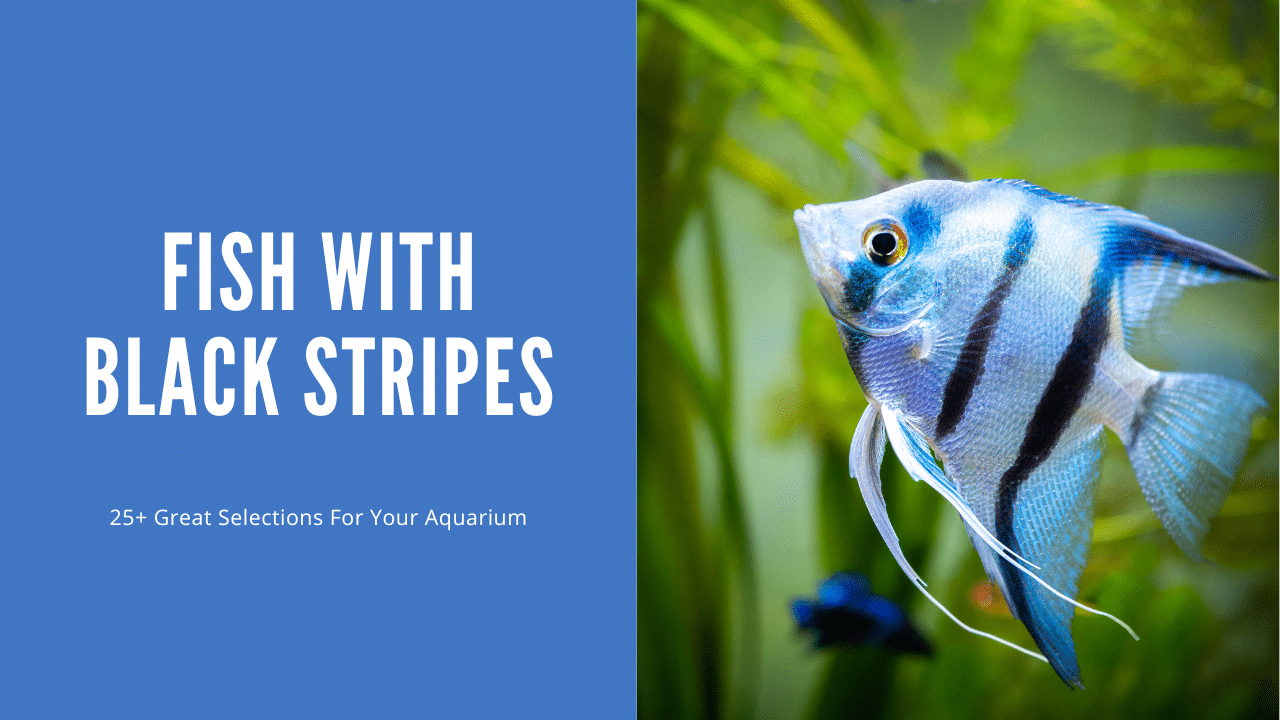Thank you for visiting! By the way… any links on this page that lead to products on Amazon and other stores/partners are affiliate links Aquarium Store Depot earns a commission if you make a purchase.
There are plenty of fish with bright colors and complicated patterns, but what if you want something more minimal, like a stripe design? Stripes are a common pattern seen in animals, including both saltwater and freshwater fish. A striped fish can help break up solid colors and shapes, making for an interesting addition to the home aquarium.
Keep reading to discover some of the most popular striped fish species available for saltwater and freshwater aquariums!
Key Takeaways
- Stripes are just one of the many color patterns freshwater and saltwater fish use to help survive in the wild.
- Fish with stripes can be black and white or feature other natural and vibrant colors, depending on the species.
- Freshwater and saltwater fish should not be chosen on appearance alone, so make sure to research all the necessary care requirements before bringing home a new addition to your aquarium!
Why Do They Have Them?
Have you ever thought about why animals look the way they do? Animals, including fish, have evolved for millions of years to develop colors and patterns that not only keep them alive but also provide the best success for passing down their genes. This is a phenomenon known as natural selection, where evolutions determine the species’ success, meaning the most opportunistic and successful traits get passed down from one generation to the next.
All this is to say that at one point in evolutionary history, stripes helped the given species survive better.
There are several reasons why fish might have evolved stripes. The first reason is that stripes aid in camouflage. Stripes break up the shape of an otherwise solid colored fish, which can make them nearly invisible to predators. Other stripes can also mimic the environment of the fish, especially if plants or coral are abundant.
Another use of stripes is for communication. This aspect is less understood, but it’s believed that fish can convey aggression, submission, or physical fitness for reproduction. In some cases, fish mimic the stripe patterns of other poisonous or venomous species to scare off potential predators, even if that specific species is harmless.
Lastly, stripes may be selectively bred within the aquarium hobby. Many species, especially freshwater fish, have been modified to express the best colors and patterns. As a result, some fish may display nearly every color and pattern combination imaginable.
Fish With Black Stripes
Here are some of the most popular freshwater and saltwater fish with stripes for the home aquarium!
1. Zebra Angelfish

- Scientific Name: Pterophyllum scalare
- Common Names: Zebra angelfish, Silver zebra angel
- Minimum Tank Size: 30 gallons
- Adult Size: 6 inches
- Temperament: Semi-aggressive
- Care Level: Easy
- Diet: Omnivore
- Origin: Selectively bred
- Temperature: 75-82° F
- Swimming Level: Middle
Zebra angels are a selectively bred type of freshwater angelfish cichlid, Pterophyllum scalare. These fish have the same care requirements as other varieties of this species but feature a perfectly curated appearance.
The zebra angel is silver with three to five black stripes that run from the dorsal fin to the stomach. These strips are usually solid but might have a misbar, or not-fully-connected, appearance. One special feature about these fish is that a stripe usually runs vertically through the eye, letting the pupil look like a part of the stripe.
2. Zebra Pleco
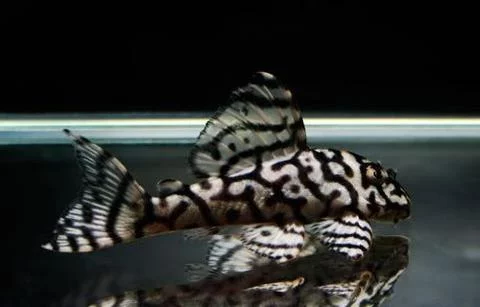
- Scientific Name: Hypancistrus zebra
- Common Names: Zebra pleco, Zebra altimira pleco, L-46
- Minimum Tank Size: 30 gallons
- Adult Size: 3-4 inches
- Temperament: Peaceful
- Care Level: Moderate
- Diet: Omnivore
- Origin: Brazil
- Temperature: 79-86° F
- Swimming Level: Bottom
The zebra pleco is one of the most sought-after species of pleco, and their price tag reflects that. These are extremely unique fish with a pure white base with black stripes across the face, body, and fins.
Though beautiful, this black-striped fish is nocturnal and might stay in the shady areas of the tank throughout the day. The zebra pleco is omnivorous and requires a diet of plant and protein-based foods, though they will not chew on driftwood, unlike other species of pleco.
3. Skunk Cory
- Scientific Name: Corydoras aracuatus
- Common Names: Skunk cory, Sands’ cory
- Minimum Tank Size: 20 gallons
- Adult Size: 2-3 inches
- Temperament: Peaceful
- Care Level: Moderate
- Diet: Omnivore
- Origin: Brazil
- Temperature: 68-77° F
- Swimming Level: Bottom
The skunk cory is one of the lesser common species of Corydoras available in the aquarium hobby, possibly due to its oversimplicity. That isn’t to say that these aren’t great nano fish to keep though!
The skunk cory is named after the singular thin black stripe that runs along either side of the dorsal fin from the head to the end of the tail fin. The rest of the body is a light brown or grey color.
Skunk cories are relatively easy to keep, like other species of cory. They are small, somewhat shy fish that do best with a soft substrate, plenty of hiding spots, and a school of at least 6 or more.
4. Frontosa Cichlid

- Scientific Name: Cyphotilapia frontosa
- Common Names: Frontosa cichlid, Front cichlid
- Minimum Tank Size: 150+ gallons
- Adult Size: 1.0-1.5 feet
- Temperament: Semi-aggressive
- Care Level: Moderate
- Diet: Carnivore
- Origin: Lake Tanganyika, Africa
- Temperature: 72-82° F
- Swimming Level: Middle to Bottom
The frontosa cichlid is a large African cichlid that is relatively difficult to keep due to its potential adult size. These are large fish that need to be kept with other fish that are also endemic to Lake Tanganyika as pH needs to be higher, between 7.5 and 9.0.
Frontosa cichlids are labeled as semi-aggressive but are more defensive of their territories than being openly aggressive to each other. It should be noted that these carnivorous fish can eat small fish once they reach larger sizes.
These cichlids vary in appearance, especially if wild-caught from different locations within the lake. In general, frontosas feature five to seven broad black bands on top of a light or pale blue color.
5. Tiger Barb
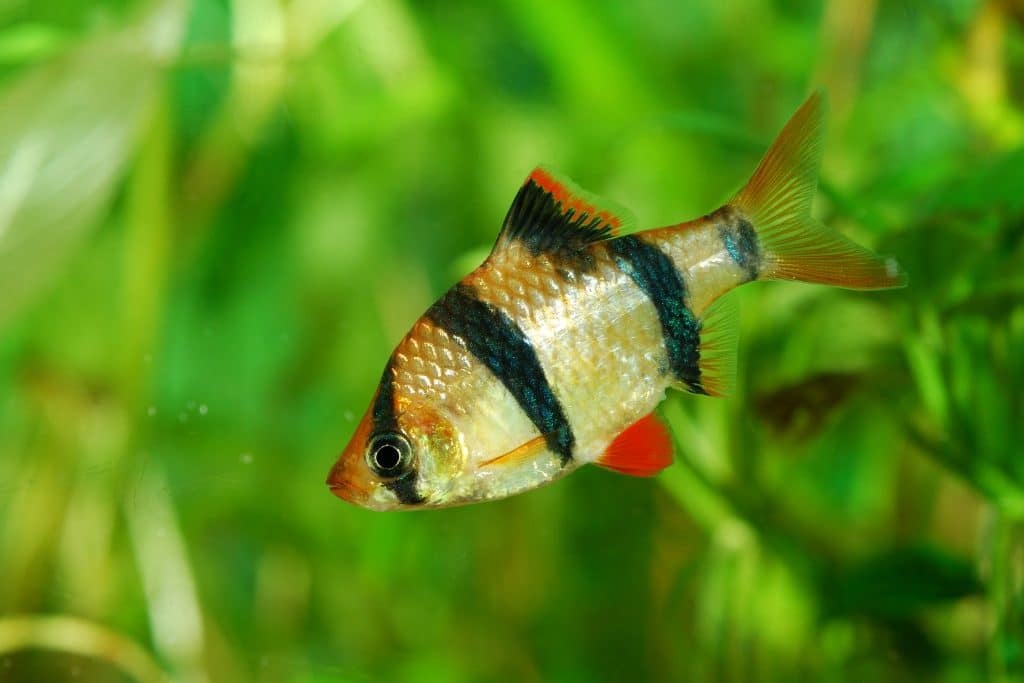
- Scientific Name: Puntius tetrazona
- Common Names: Tiger barb, Sumatra barb
- Minimum Tank Size: 30 gallons
- Adult Size: 2-4 inches
- Temperament: Semi-aggressive
- Care Level: Moderate
- Diet: Omnivore
- Origin: Sumatra and Borneo
- Temperature: 74-79° F
- Swimming Level: Middle
For years, the tiger barb was one of the most popular freshwater fish available in the aquarium trade. These fish are honey-brown with red fins and four black stripes. These fish might look like a species of tetra, but they are semi-aggressive fish that can fin nip and attack other more peaceful species.
A loose schooling fish, tiger barbs must be kept in groups of at least 6 or more. These are active fish that will move together throughout the tank looking for food or possibly to terrorize other fish.
True tiger barbs are naturally colored. However, these fish have been genetically modified to exhibit bright colors by GloFish, like neon yellow, pink, and green. Some barbs keep their stripes while others are solid colors.
6. Zebra Danio
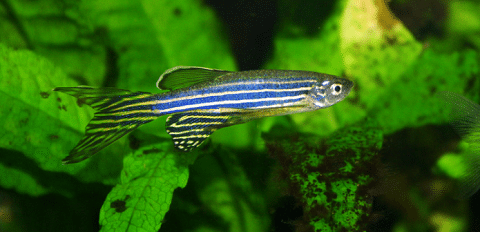
- Scientific Name: Danio rerio
- Common Names: Zebra danio, Zebrafish, Striped danio
- Minimum Tank Size: 10 gallons
- Adult Size: 2-4 inches
- Temperament: Peaceful
- Care Level: Easy
- Diet: Omnivore
- Origin: Asia
- Temperature: 64-75° F
- Swimming Level: Top and Middle
Zebra danios are very active striped fish that like to swim in schools at the top of the aquarium. Unlike the other fish listed, zebra danios are a coldwater fish species that prefers subtropical water temperatures.
These fish are torpedo shaped with several horizontal black stripes that run from the end of the tail to the head. These fish are silvery-yellow underneath the stripes, though they might feature more vibrant yellow fins.
Zebra danios are one of the least-demanding fish to keep in the aquarium hobby and easily adapt to a variety of aquarium setups.
7. Siamese Algae Eater

- Scientific Name: Crossocheilus siamensis
- Common Names: Siamese algae eater, SAE, Siamese flying fox
- Minimum Tank Size: 30 gallons
- Adult Size: 4-6 inches
- Temperament: Peaceful
- Care Level: Moderate
- Diet: Omnivore but mainly herbivorous
- Origin: Southeast Asia
- Temperature: 75-79° F
- Swimming Level: Bottom
The Siamese algae eater, not to be confused with the more aggressive Chinese algae eater (Gyrinocheilus aymonieri), is one of the best algae eaters for the freshwater aquarium. Siamese algae eaters have a brownish-silver body with one thick black band that goes from the mouth to the base of the forked caudal fin.
These fish have an elongated body that helps them stay suctioned to rocks in their naturally fast-moving water environments. Siamese algae eaters may be present in groups as juveniles but can become slightly territorial as they age.
8. Convict Cichlid

- Scientific Name: Amatitlania nigrofasciata
- Common Names: Convict cichlid, Black convict cichlid, Zebra cichlid
- Minimum Tank Size: 30 gallons
- Adult Size: 4-6 inches
- Temperament: Aggressive
- Care Level: Moderate
- Diet: Omnivore
- Origin: Central America
- Temperature: 72-82° F
- Swimming Level: Middle
An aggressive species of Central American cichlid, the convict cichlid is an attractive fish with a deep blue body and mottled vertical black bands. These stripes are not neat, have rigid edges, and might not connect across the width of the fish.
Some special consideration is needed when housing these fish due to their aggressive nature. A minimum tank size of 30 gallons is recommended when keeping one or two, but at least 55 gallons is necessary when keeping other species.
9. Black Neon Tetra

- Scientific Name: Hyphessobrycon herbertaxelrodi
- Common Names: Black neon tetra
- Minimum Tank Size: 10 gallons
- Adult Size: 1-2 inches
- Temperament: Peaceful
- Care Level: Easy
- Diet: Omnivore
- Origin: South America
- Temperature: 72-77° F
- Swimming Level: Middle
Not actually related to the famous neon tetra (Paracheirodon innesi), the black neon tetra is named after the two horizontal black and white stripes that run along the side of the fish; the white stripe is on top of the black stripe. Underneath, the fish is a yellowy-silver.
A type of schooling fish, black neon tetras need to be kept in groups of at least 6 or more. They can be timid with bigger, more active species, but excel in a community tank setting.
10. Clown Loach
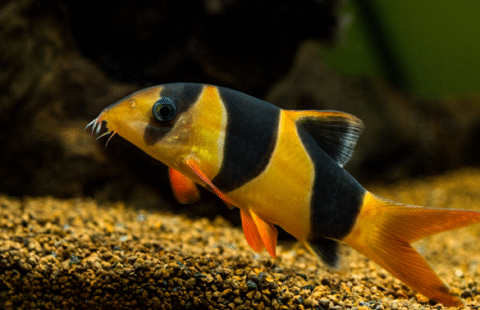
- Scientific Name: Chromobotia macracantha
- Common Names: Clown loach, Tiger botia
- Minimum Tank Size: 125+ gallons
- Adult Size: 1 foot
- Temperament: Semi-aggressive
- Care Level: Moderate
- Diet: Omnivore
- Origin: Sumatra and Borneo
- Temperature: 72-86° F
- Swimming Level: Bottom
The clown loach should not be underestimated. For a long time, these colorful fish were considered to be beginner fish due to their relatively easy care and juvenile size. It wasn’t until recently that hobbyists discovered the true adult size of these fish, which is about a foot or more. Keep in mind that clown loaches like to school and need to be kept in large groups.
Still, the clown loach is one of the most attractive bottom-dwellers for the freshwater aquarium. These are orange fish with black stripes along the sides of their body. The caudal, ventral, and anal fins are typically dark red while the dorsal fin is black.
11. Golden Mbuna

- Scientific Name: Melanochromis auratus
- Common Names: Golden mbuna
- Minimum Tank Size: 55 gallons
- Adult Size: 4-5 inches
- Temperament: Aggressive
- Care Level: Moderate
- Diet: Omnivore
- Origin: Lake Malawi, Africa
- Temperature: 75-82° F
- Swimming Level: Middle
The golden mbuna is an attractive African cichlid with varying appearances, but never without stripes! Male golden mbuna cichlids especially change colors between breeding periods. Juvenile males and females typically display a deep yellow base color with horizontal black stripes. A breeding male will invert his colors over a few days, switching to a largely black body, with a silvery dorsal and white lateral line.
Golden mbunas are some of the most aggressive cichlids available and will need appropriate tank mates. Only one male should be kept per tank.
12. Electric Blue Johanni
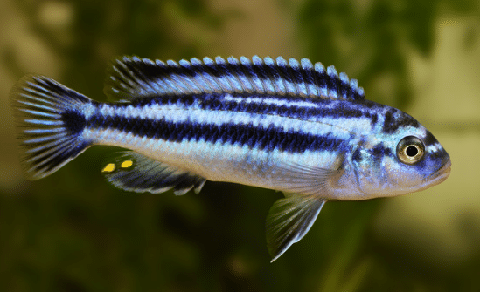
- Scientific Name: Melanochromis johannii
- Common Names: Electric blue johanni, Rock-dwelling mbuna
- Minimum Tank Size: 55 gallons
- Adult Size: 4-5 inches
- Temperament: Semi-aggressive
- Care Level: Moderate
- Diet: Omnivore
- Origin: Lake Malawi, Africa
- Temperature: 75-82° F
- Swimming Level: Middle
Another striped cichlid, the electric blue johanni mbuna isn’t as aggressive as the golden mbuna. This makes them more appropriate for a mbuna community aquarium as long as the tank size allows.
While male electric blue johanni cichlids are striped tropical fish, with a shocking blue base color and vertical bars across their body, females look entirely different. Female electrics are fully yellow, which can make it slightly challenging to identify this species.
13. Demasoni Cichlid
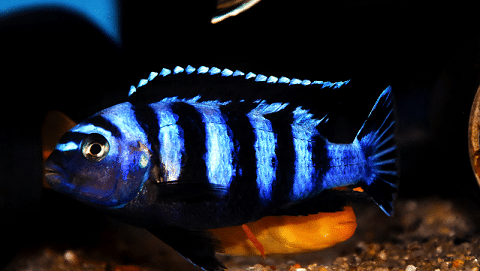
- Scientific Name: Pseudotropheus demasoni
- Common Names: Demasoni cichlid
- Minimum Tank Size: 55 gallons
- Adult Size: 3-5 inches
- Temperament: Aggressive
- Care Level: Moderate
- Diet: Omnivore
- Origin: Lake Malawi, Africa
- Temperature: 75-82° F
- Swimming Level: Middle
Specific to the Pombo Rock ecosystem in Tanzania, the Demasoni cichlid isn’t a common fish to see available. These fish stay in rocky areas, rarely swimming into open water. This means the aquarium should be filled with cracks and crevices for them to live.
At first glance, this fish might resemble a front cichlid. These fish are light blue with vertical black stripes. There is no immediately noticeable difference between males and females, though males may be slightly larger and more territorial.
14. Royal Heckel Cross Discus
- Scientific Name: Symphysodon spp.
- Common Names: Royal heckel cross discus
- Minimum Tank Size: 55 gallons
- Adult Size: 8-12 inches
- Temperament: Generally peaceful
- Care Level: Moderate to Expert
- Diet: Omnivore
- Origin: South America
- Temperature: 84-86° F
- Swimming Level: Middle
Discus are beautiful fish that have been selectively bred to display a variety of colors and patterns. The royal heckel cross discus is a mixture of orange, red, and blue with several vertical black stripes that vary in width. These are a specific variety of discus, so they may be more difficult to find and more expensive.
Discus are challenging aquarium fish. They do best when kept in small groups in a tank of their own. They are highly sensitive to improper water conditions and usually require more maintenance than other fish.
15. Pencil Fish

- Scientific Name: Nannostomus spp.
- Common Names: Pencil fish
- Minimum Tank Size: 20 gallons
- Adult Size: 1-2 inches
- Temperament: Peaceful
- Care Level: Moderate
- Diet: Omnivore
- Origin: South America
- Temperature: 75–80° F
- Swimming Level: Middle to Top
An unusual schooling fish to find in the average hobbyist’s tank, the pencil fish is named after its swimming behavior that allows them to swim at a 45-degree angle. Pencil fish describes a genus of fish, in which there are almost 20 different species.
Here are some that are available in the aquarium hobby:
- Three-lined pencil fish (Nannostomus trifasciatus)
- Beckford’s pencil fish (Nannostomus beckfordi)
- Purple pencil fish (Nannostomus rubrocaudatus)
These fish mostly feature natural coloration with various browns, yellows, whites, and reds. Most of the species also have one or more horizontal black stripes that trail from the head to the tail.
16. Clown Killifish
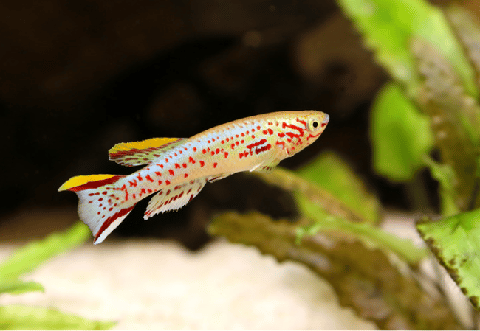
- Scientific Name: Epiplatys annulatus
- Common Names: Clown killifish, Banded panchax
- Minimum Tank Size: 10 gallons
- Adult Size: 1-2 inches
- Temperament: Peaceful
- Care Level: Easy
- Diet: Omnivore
- Origin: West Africa
- Temperature: 68-80° F
- Swimming Level: Top
Killifish are an often overlooked option for the freshwater aquarium. This black and white fish with red fins looks just like a painted clown face! Sometimes, the white is replaced with a pale yellow.
Clown killis are small and easy-to-keep fish that are relatively forgiving of water parameters. They don’t school, but they like to be kept in small groups with one male and several females. Otherwise, clown killifish excel in a heavily planted aquarium with other peaceful tank mates.
17. Black Banded Leporinus
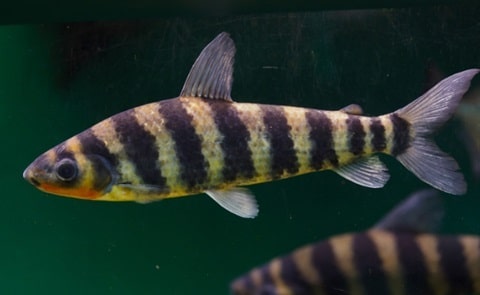
- Scientific Name: Leporinus fasciatus
- Common Names: Black banded leporinus, Banded leporinus
- Minimum Tank Size: 75 gallons
- Adult Size: 1 foot
- Temperament: Semi-aggressive
- Care Level: Moderate
- Diet: Omnivore
- Origin: South America
- Temperature: 72-82° F
- Swimming Level: Middle to Bottom
A very popular fish several years ago, the black banded leporinus is still a favorite fish with black stripes. These black and yellow fish increase stripes as they age, with juveniles having five bands and adults having ten.
These are very interesting fish that can jump high out of the water. Because of this, a tight aquarium hood is necessary. They are also large fish that are aggressive towards their own species and other similar-looking fish. Black banded leporinus originate from high-flow rivers and need similar conditions in the aquarium setting.
18. Convict Tang

- Family: Acanthuridae
- Size: 8 inches
- Origin: Indo-Pacific
- Tank Size: 125 gallons
- Reef Safe: Yes
- Available As Tank Bred: No
Convict tangs are a popular saltwater species, possibly because they don’t look like any other tang. These black and white fish have very delicate black stripes along their body. Some individuals may feature varying shades of yellow along their dorsal regions.
Regardless of their appearance, these are still tangs that require a large tank for swimming and grazing. They are one of the more peaceful species of tang available, and other related species might be overly aggressive. It should also be noted that these fish are often sick or stressed when first introduced into the aquarium.
19. Three And Four-Stripe Damselfish
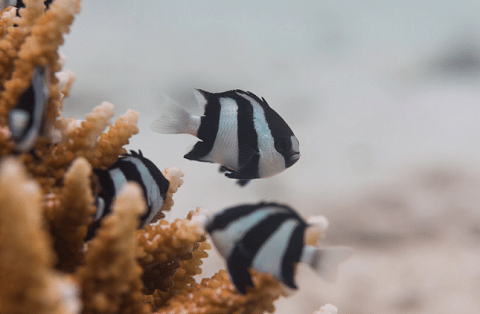
- Family: Pomacentridae
- Size: 2-4 inches
- Origin: Western Pacific
- Tank Size: 10 gallons
- Reef Safe: Yes
- Available As Tank Bred: Yes
Three and four stripe damselfish are a popular addition to the novice’s saltwater aquarium. These are hardy, inexpensive fish that are almost guaranteed to survive all beginner’s mistakes. However, hobbyists quickly find out that these black and white damsel fish are overly aggressive and often need to be rehomed after a few months.
These are the most pure black and white fish available on this list, with white bodies and three or four broad black stripes accordingly. Aggression levels do not vary much between the two species. If you want a less aggressive damsels, try a yellow tail or azure.
20. Black And Gold Chromis Damsel

- Family: Pomacentridae
- Size: 3-5 inches
- Origin: Indo-West Pacific
- Tank Size: 30 gallons
- Reef Safe: Yes
- Available As Tank Bred: No
The black and gold chromis damsel can look a lot different depending on how old your fish is. As a juvenile, this fish is yellow with black stripes that run parallel along the body. As adults, these fish’s faces turn brown while the end half of their body stays yellow.
Black and gold chromis damsels aren’t commonly seen in the aquarium hobby but should be treated as another species of damsel. That means the same levels of aggression but also the same hardiness and ease of keeping.
21. Lionfish
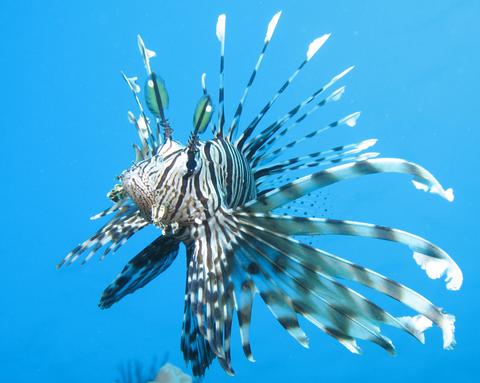
- Family: Scorpaenidae
- Size: <18 inches
- Origin: Indian and Western Pacific Oceans
- Tank Size: 55 gallons
- Reef Safe: Yes
- Available As Tank Bred: No
There is some discussion about keeping these striped marine fish in the aquarium. The lionfish is native to the Indian and Western Pacific Oceans but has since devastated portions of the Western Atlantic Ocean. Regardless, lionfish are a popular addition to the reef tank; these fish can be kept with colorful corals, but tank mates need to be carefully selected in return.
There are many species of lionfish, but most are red and white striped. This coloration continues to the dorsal spines and other fins.
22. Banded Angelfish
- Family: Pomacanthidae
- Size: 4-5 inches
- Origin: Indo-Pacific
- Tank Size: 75 gallons
- Reef Safe: With caution
- Available As Tank Bred: No
The banded angelfish (video source) is one of the most obvious fish with black stripes on this list! These saltwater angelfish have evenly spaced black and white stripes along the sides of their body. Some individuals have shades of yellow on their bellies.
The banded angelfish is a type of angel, meaning that they may or may not be reef-safe; they may pick at corals and small crustaceans. These black and white fish can be territorial and difficult to feed. Some helpful tips suggest feeding live sponges, making this a difficult fish to keep for inexperienced hobbyists.
If you are looking for a more hardy stripped angelfish (though it’s a yellow not black stripe), you can check out the Asfur Angelfish from the red sea, it gets a lot larger, but adapts better in captivity. A Lamarck Angelfish is also another great alternative.
23. Heniochus Butterflyfish

- Family: Chaetodontidae
- Size: 8-10 inches
- Origin: Indo-Pacific
- Tank Size: 125 gallons
- Reef Safe: No
- Available As Tank Bred: Yes
The heniochus butterflyfish is an unassuming fish with some special requirements. This is a large black and white striped fish originating from the Indo-Pacific region that cannot be kept with corals. Other species should also be added alongside the heniochus butterfly fish or beforehand as these fish can become aggressive.
If you have the space, the heniochus butterflyfish is bold with a white body, two broad vertical black stripes, and yellow fins.
24. Banggai Cardinalfish
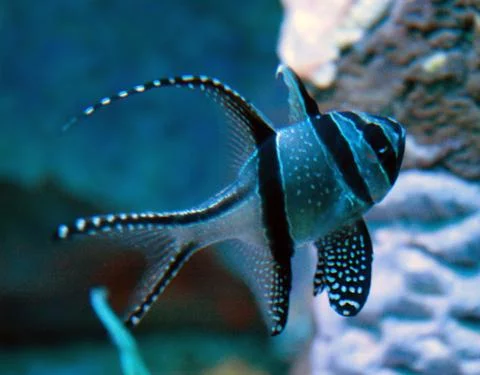
- Family: Apogonidae
- Size: 2-3 inches
- Origin: Banggai Islands, Indonesia
- Tank Size: 10 gallons
- Reef Safe: Yes
- Available As Tank Bred: Yes
An endangered species (though all fish purchased now are tank bred), the Banggai cardinal is a beautiful and easy-to-keep small fish with black stripes. These are signature fish of the reef tank and are perfectly compatible with a variety of corals and community fish. These cardinals can be paired and successfully bred at the hobbyist level.
The Banggai cardinal has two high dorsal fins that extend the appearance of their vertical stripes. These dark stripes are also outlined in a pearlescent white, which further accentuates their appearance.
25. Flame Angelfish
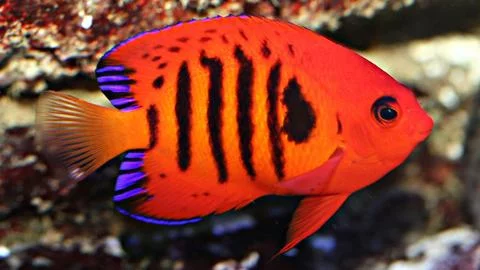
- Family: Pomacanthidae
- Size: 4-6 inches
- Origin: Pacific Ocean
- Tank Size: 75 gallons
- Reef Safe: With Caution
- Available As Tank Bred: No
If you’re looking for a fish with less obvious stripes, then the flame angel might spark some ideas. The flame angelfish is a fish with black stripes, but minimally. By this, we mean that the short, mottled black stripes are more like an accent than a feature of this fish’s bright red and orange coloration.
The flame angelfish is a popular reef fish, though not every individual is safe with corals. Otherwise, these saltwater fish are relatively easy to keep as long as they are added last to the aquarium.
Bonus Species
Here are species we run out of space to write but also have black stripes:
- Sergeant major
- Kribensis
- Bolivian Ram
If we miss a fish you like add it in the comments and we will include it when we update the post.
FAQs
What fish has a black stripe?
There are many fish with black stripes! Some popular freshwater fish include the zebra danio, zebra angelfish, and convict cichlid. Some marine life options are the convict tang, lionfish, and the black and white clownfish.
What kind of fish is white with black stripes?
Not all striped fish are black and white, but here are some of the most common species with that color combination: skunk cory, zebra danio, striped damselfish, and Banggai cardinals.
What type of fish has stripes?
Stripes are a common pattern to see on both freshwater and saltwater fish that live among plants or corals. This pattern can help break up the silhouette of the fish, helping protect them from predators.
What is a small freshwater fish with black stripes?
The smallest species of striped freshwater fish on this list is the clown killifish.
What is the black and white striped fish called?
There is no specific name for a black and white striped fish. Sometimes, there is an indication as to the color of the fish in the name, but most times they are named after a behavior, overall color, or scientist.
What is the fish that looks like a zebra?
The zebra pleco looks most like a zebra, with bright white and deep black alternating stripes.
Final Thoughts
Stripes are a great way to add interest and color to a freshwater or saltwater aquarium. While some striped fish are black and white, others feature bright colors and interesting patterns alongside defined lines. Before adding a striped fish to your aquarium, make sure that the species is compatible with the other fish in the aquarium.
- About the Author
- Latest Posts
I’m thrilled that you found Aquarium Store Depot! Here you’ll find information on fish, aquariums, and all things aquatics related. I’m a hobbyist (being doing this since I was 11) and here to help other hobbyists thrive with their aquariums! I adhere to a high quality Editorial Process and Review products with real life field usage and practical analysis.

